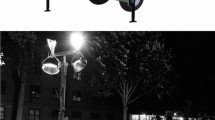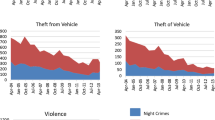Abstract
Research on the effect of street lighting on crime and fear of crime has received much attention, especially between 1970s and early 2000s. Yet no study has documented an empirical method for choosing where to best site street lights for the purpose of crime prevention. This study describes a statistical clustering method (Kohonen’s SOM) that can be used to identify microplaces where crimes mostly occur during nighttime within stable crime hot spots. The results of this clustering analysis were visually examined and compared with streets, which are located near the University of Cincinnati West Campus and selected for lighting during early 2014. The findings revealed temporal patterns of crime within crime hot spots. In addition, there is a substantial overlap between the areas identified as heavily dark-time locations by clustering analysis and previously lighted streets determined by the city of Cincinnati managers. Implications of the study are discussed in conclusions.


Similar content being viewed by others
References
AASHTO (American Association of State Highways and Transportation Officials). 2010. An informational guide to roadway lighting. Washington, D.C.: AASHTO.
Agnew, R. 1992. Foundation for a general strain theory of crime and delinquency. Criminology 30(1): 47–88.
Akers, R.L. 1990. Rational choice, deterrence, and social learning theory in criminology: The path not taken. Journal of Criminal Law & Criminology 81(3): 653–676.
Ashby, M.P.J., and K.J. Bowers. 2013. A comparison of methods for temporal analysis of aoristic crime. Crime Science: An Interdisciplinary Journal 2(1): 1–16.
Balbi, A., and A.-M. Guerry. 1829. Statistique comparée de l’état de l’instruction et du nombre des crimes dans les divers arrondissements des Académies et des Cours Royales de France. Paris: Unknown Publisher.
Boyce, P.R. 2008. Lighting for driving: Roads, vehicles, signs, and signals. Boca Raton, FL: CRC Press.
Boyce, P.R. 2014. Human factors in lighting. 3rd ed. Boca Raton, FL: CRC Press.
Brantingham, P.J., and P.L. Brantingham (eds.). 1981. Environmental criminology. Beverly Hills, CA: Sage Publications.
Bushell, M.A., B.W. Poole, C.V. Zegneer, and D.A. Rodriguez. 2013. Costs for pedestrian and bicyclist infrastructure improvements: A resource for researchers, engineers, planners, and the general public. Chapel Hill: University of North Carolina Highway Safety Research Center, University of North Carolina.
Clarke, R.V., and D.B. Cornish. 1985. Modeling offenders’ decisions: A framework for research and policy. Crime and Justice 6: 147–185.
Clarke, R.V., and J.E. Eck. 2005. Crime analysis for problem solvers in 60 small steps. Washington, D.C.: U.S. Department of Justice.
Cohen, L.E., and M. Felson. 1979. Social change and crime rate trends: A routine activity approach. American Sociological Review 44(4): 588–608.
Cohn, E.G. 1993. The prediction of police calls for service: The influence of weather and temporal variables on rape and domestic violence. Journal of Environmental Psychology 13(1): 71–83.
Cornish, D.B., and R.V. Clarke. 2003. Opportunities, precipitators and criminal decisions: A reply to Wortley’s critique of situational crime prevention. In Theory for practice in situational crime prevention and crime prevention studies, vol. 16, ed. M.J. Smith, D.B. Cornish, 41–96. Monsey, NY: Criminal Justice Press.
Eck, J.E. 1994. Drug markets and drug places: A case–control study of the spatial structure of illicit drug dealing. Unpublished doctoral dissertation. Baltimore, MD: University of Maryland.
Eck, J.E., and D.L. Weisburd. 1995. Crime places in crime theory. In Crime and place, ed. John E. Eck, David Weisburd. Monsey, NY: Criminal Justice Press.
Eck, J.E., and D.L. Weisburd. 2015. Crime places in crime theory. Crime Prevention Studies 4: 1–33.
Eichenthal, D. 2016. It’s not just Petersburg. The Washington Post. Retrieved October 14th 2017 from https://www.washingtonpost.com/opinions/its-not-just-petersburg/2016/10/14/9fd1a2a2-8f2c-11e6-a6a3-d50061aa9fae_story.html?utm_term=.57cdda4a9a8d.
Farrell, G., and P. Pease. 1994. Crime seasonality: Domestic disputes and residential burglary in Merseyside 1988–90. The British Journal of Criminology 34(4): 487–498.
Farrington, D.P., and B.C. Welsh. 2002. Effects of improved street lighting on crime: A systematic review. London: Home Office.
Felson, M. 1986. Linking criminal choices, routine activities, informal control, and criminal outcomes. In The reasoning criminal: Rational choice perspectives on offending, ed. D.B. Cornish, R.V. Clarke. New Brunswick: Transaction Publishers.
Fisher, B., and J.L. Nasar. 1992. Fear of crime in relation to three exterior site features: Prospect, refuge and escape. Environment and Behavior 24(1): 35–65.
Gottfredson, M.R., and T. Hirschi. 1990. A general theory of crime. Stanford: Stanford University Press.
Haans, A., and Y.A. De Kort. 2012. Light distribution in dynamic street lighting: Two experimental studies on its effects on perceived safety, prospect, concealment, and escape. Journal of Environmental Psychology 32(4): 342–352. https://doi.org/10.1016/j.jenvp.2012.05.006.
Heller, N.B., and R.E. Markland. 1970. A climatological model for forecasting the demand for police service. Journal of Research in Crime and Delinquency 7(2): 167–176.
Kelling, G.L., T. Pate, D. Dieckman, and C.C. Brown. 1974. The Kansas city preventive patrol experiment: A summary report. The Kansas City Preventive Patrol Experiment: A Summary Report.
Kohonen, T. 1998. The self-organizing map. Neurocomputing 21(1): 1–6.
Kohonen, T., M.R. Schroeder, and T.S. Huang. 2001. Self-organizing maps. New York: Springer.
Lab, S.P., and J.D. Hirschel. 1988. Climatological conditions and crime: The forecast is…? Justice Quarterly 5(2): 281–299.
Laycock, G. 2005. Defining crime science. In Crime science: New approaches to preventing and detecting crime, ed. M.J. Smith, N. Tilley, 3–24. Cullompton: Willan.
Nasar, J.L., B. Fisher, and M. Grannis. 1993. Proximate physical cues to fear of crime. Landscape and Urban Planning 26(1–4): 161–178.
Newman, O. 1972. Defensible space. New York: Macmillan.
Pain, R., R. MacFarlane, K. Turner, and S. Gill. 2006. When, where, if, and but: Qualifying GIS and the effect of street lighting on crime and fear. Environment and Planning A 38(11): 2055–2074.
Painter, K. 1996. The influence of street lighting improvements on crime, fear, and pedestrian street use after dark. Landscape and Urban Planning 35(2): 193–201.
Payne, T.C., and K. Gallagher. 2016. The importance of small units of aggregation: Trajectories of crime at addresses in Cincinnati, Ohio, 1998-2012. Criminology, Criminal Justice, Law and Society 17(1): 20–36.
Pease, K. 1999. A review of street lighting evaluations: Crime reduction effects. In Surveillance of public space: CCTV, street lighting, and crime prevention. Crime prevention studies, vol. 10, eds. K. Painter, N. Tilley. Monsey, NY: Criminal Justice Press.
Peeters, L., and A. Dassargues. 2006. Comparison of Kohonen’s self-organizing map algorithm and principal component analysis in the exploratory data analysis of a groundwater quality dataset. In GeoENV2006 pp. 1–12.
Quinet, K.D., and S. Nunn. 1998. Illuminating crime: The impact of street lighting on calls for police service. Evaluation Review 22: 751–779.
Ratcliffe, J.H., and M.J. McCullagh. 1998. Aoristic crime analysis. International Journal of Geographical Information Science 12(7): 751–764.
Rengert, G.F. 1997. Auto theft in central Philadelphia. Policing for Prevention: Reducing Crime, Public Intoxication and Injury 7: 199–219.
Sampson, R.J., S.W. Raudenbush, and F. Earls. 1997. Neighborhoods and violent crime: A multilevel study of collective efficacy. Science 277(5328): 918–924.
Schneider, G.S. 2016. City on the brink: Petersburg can’t pay its bills, and time is running out. The Washington Post. Retrieved 9th September 2017 from https://www.washingtonpost.com/local/virginia-politics/city-on-the-brink-petersburg-cant-pay-its-bills-and-time-is-running-out/2016/09/04/9327c962-6ef9-11e6-8533-6b0b0ded0253_story.html?tid=a_inl&utm_term=.db16234d7499.
Shaw, C.R., and H.D. McKay. 1942. Juvenile delinquency and urban areas. Chicago: University of Chicago Press.
Sherman, L.W., P.R. Gartin, and M.E. Buerger. 1989. Hot spots of predatory crime: Routine activities and the criminology of place. Criminology 27(1): 27–56.
Tien, J.M., V.F. O’Donnell, A. Barnett, and P.B. Mirchandani. 1979. Phase I report: Street lighting projects. Washington, DC: US Government Printing Office.
Tompson, L., and K. Bowers. 2013. A stab in the dark? A research note on temporal patterns of street robbery. Journal of Research in Crime and Delinquency 50(4): 616–631.
US Naval Observatory. 2016. Sun or moon rise/set table for one year. United States Naval Observatory Astronomical Applications Department. Retrieved 1st June 2016 from http://aa.usno.navy.mil/data/docs/RS_OneYear.php.
Weisburd, D.L., W. Bernasco, and G. Bruinsma (eds.). 2008. Putting crime in its place. New York: Springer.
Weisburd, D.L., S. Bushway, C. Lum, and S.M. Yang. 2004. Trajectories of crime at places: A longitudinal study of street segments in the city of Seattle. Criminology 42(2): 283–322.
Welsh, B.C., and D.P. Farrington. 2008. Effects of improved street lighting on crime. Campbell Systematic Reviews. https://doi.org/10.4073/csr.2008.13.
Wright, R.T., and S.H. Decker. 2011. Armed robbers in action: Stickups and street culture. Lebanon: UPNE.
Author information
Authors and Affiliations
Corresponding author
Rights and permissions
About this article
Cite this article
Deryol, R., Payne, T.C. A method of identifying dark-time crime locations for street lighting purposes. Crime Prev Community Saf 20, 47–62 (2018). https://doi.org/10.1057/s41300-017-0035-2
Published:
Issue Date:
DOI: https://doi.org/10.1057/s41300-017-0035-2




